Matsumoto (Los Angeles, CA)
Matsumoto Restaurant
8385 Beverly Blvd, Los Angeles, CA 90048
323.653.0470
www.matsumoto-restaurant.com
Sat 02/24/2018, 06:00p-10:00p

It'd been a while since I'd done a kaiseki-style meal, and I was recently made aware of such a menu at Matsumoto, which came highly recommended by an acquaintance of mine. The place is basically an evolution of the old Hirozen in Beverly Grove, now run by its former head chef Naruki Matsumoto.
Matsumoto was born in Osaka, and relocated to the US in 1999. He soon secured a position at the Valley's iconic Sushi Nozawa, working under none other than Kazunori Nozawa himself. In 2001, he began cooking at Hirozen Gourmet, a longstanding Japanese eatery that was opened in 1989 by Chef Hiroji Obayashi. He was quickly promoted to head sushi chef, and stayed at that position for 15 years before purchasing the restaurant from Tuk Son Kwak (who'd apparently bought the place in 2010) and re-opening it as Matsumoto in June 2016.

Matsumoto takes over Hirozen's old corner location inside the unassuming Orlando Center strip mall. The decor hasn't changed all that much.
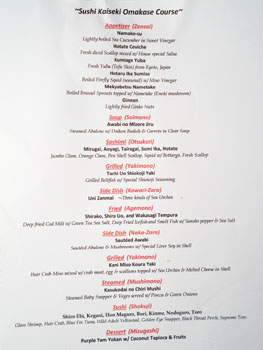
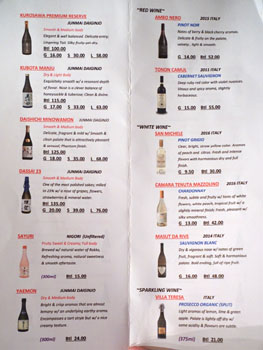
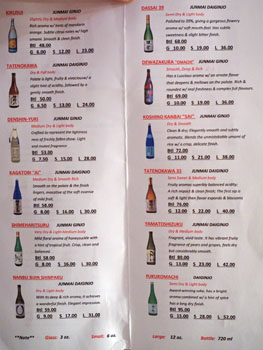
The staff printed out our sushi kaiseki omakase menus ahead of our arrival, which was a nice touch. It normally starts at $160pp, though we'd requested a price point of $250. In hindsight, we probably should've just stuck with the $160, since it didn't seem like the restaurant was quite comfortable with the higher cost. We were also presented with a brief list of sakes and wines, while corkage was $25 a pop. Click for larger versions.
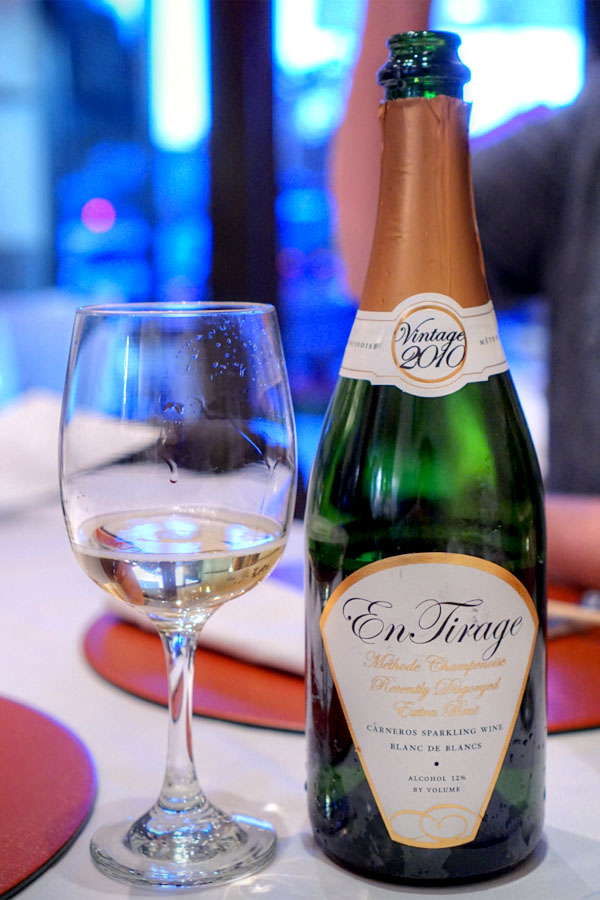
One of my dining companions had brought along three bottles of sparkling wine, which we drank over the course of the meal. Up first was the 2010 En Tirage Blanc de Blancs, composed of 100% Chardonnay from Carneros. On the nose I got a strong toastiness, along with nutty, funky elements and a fruity layer underneath it all. Taste-wise, I found it again bready, nutty, with an oxidative quality, light citrus, and plenty of acidity to boot.
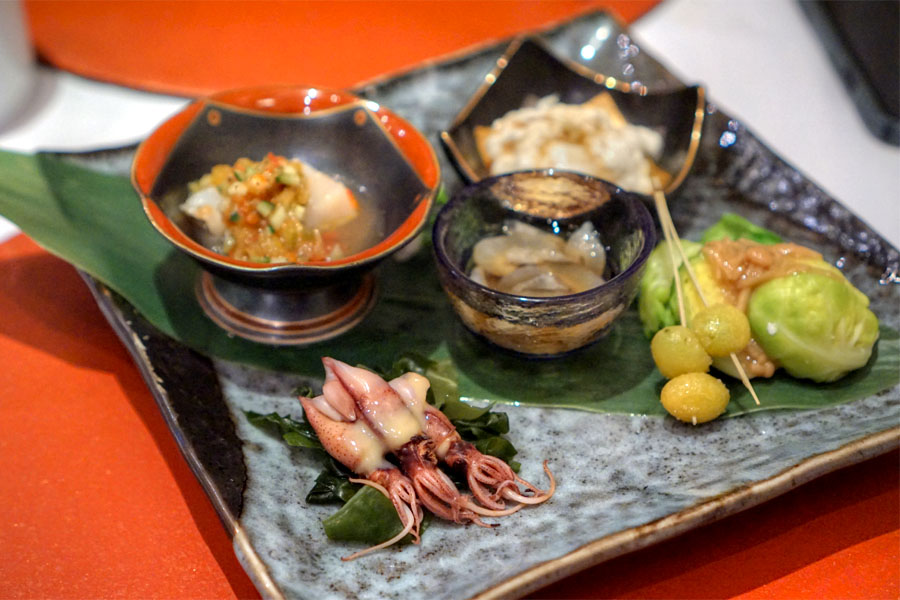
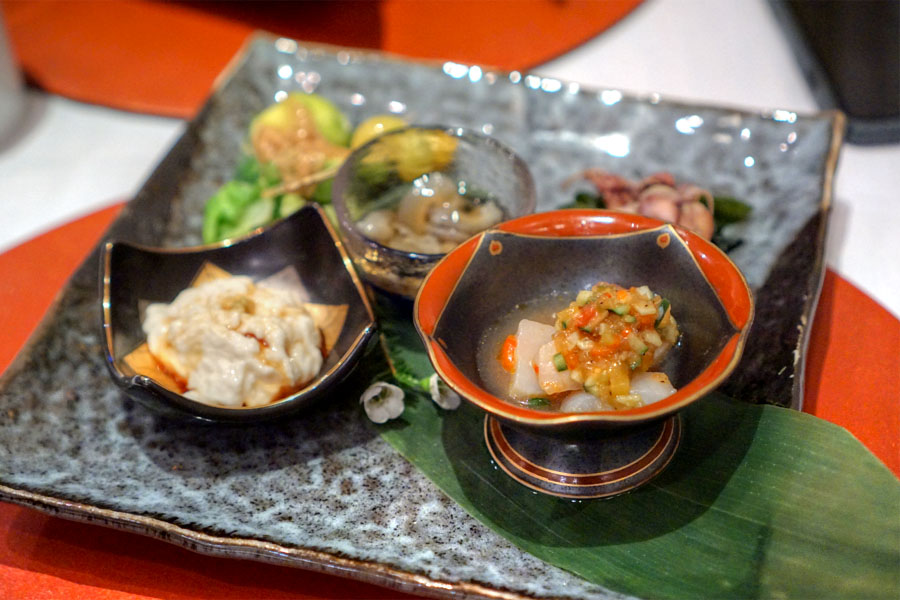
1: {Appetizer/Zensai}
Our first course consisted of a sextet of zensai: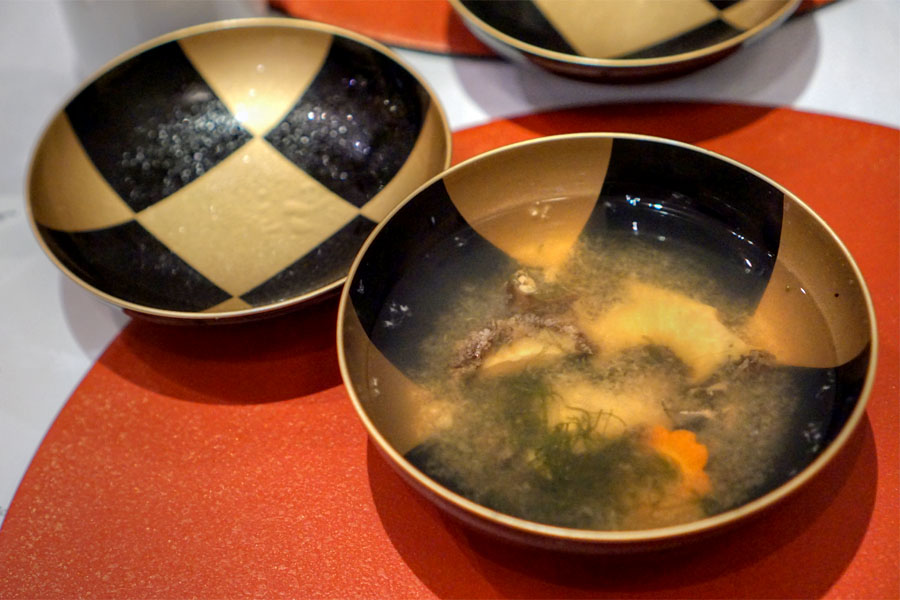
2: {Soup/Suimono} Awabi no Mizore Jiru | Steamed Abalone w/ Daikon Radish & Carrots in Clear Soup
Slivers of abalone arrived delightfully tender, their mild brine heightened by strands of seaweed and the dish's mild broth. An appropriate cold weather soup.
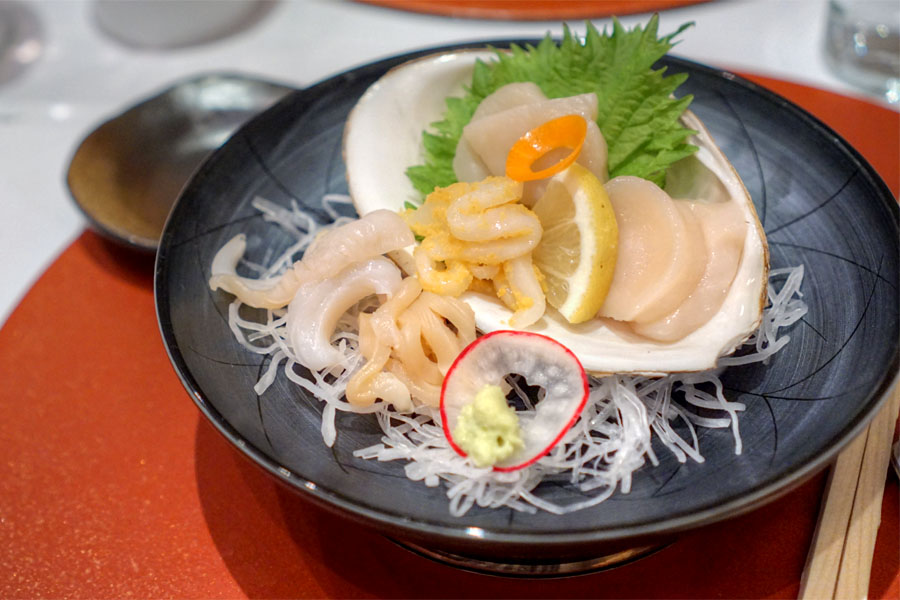
3: {Sashimi/Otsukuri} Mirugai, Aoyagi, Tairagai, Sumi Ika, Hotate | Jumbo Clam, Orange Clam, Pen Shell Scallop, Squid w/ Bottarga, Fresh Scallop
Our sashimi moriawase, curiously enough, was comprised solely of shellfish: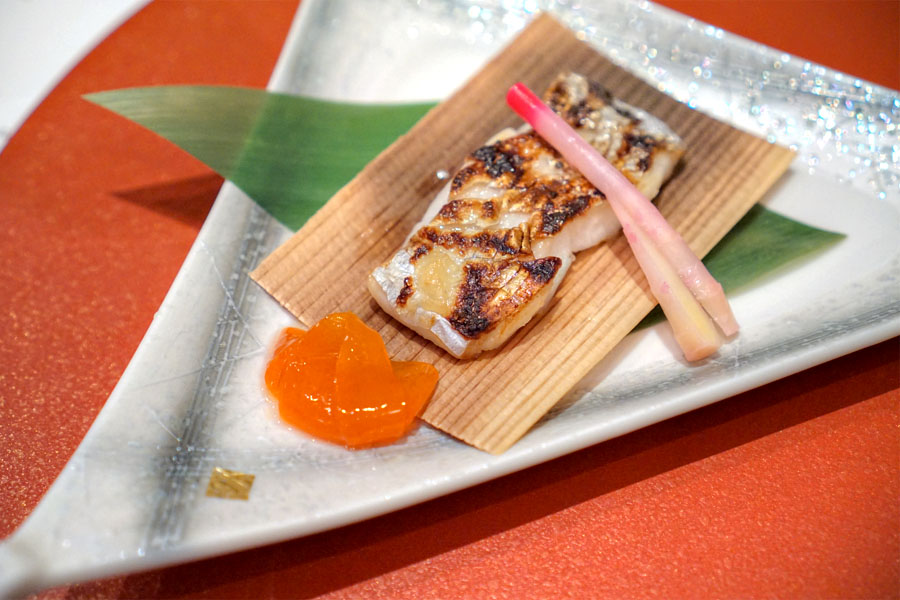
4: {Grilled/Yakimono} Tachi Uo Shiokoji Yaki | Grilled Beltfish w/ Special Shiokoji Seasoning
A meaty cut of beltfish was excellent, with a balance of brine, char, and sweetness from the shio koji. The preparation actually recalled the ubiquitous dish of saikyo-yaki cod, and I appreciated the counterpoint provided by the tangy, salty hajikami (pickled ginger shoot). The candied kumquat was unexpected, though, and I'm not quite sure it needed to be there.
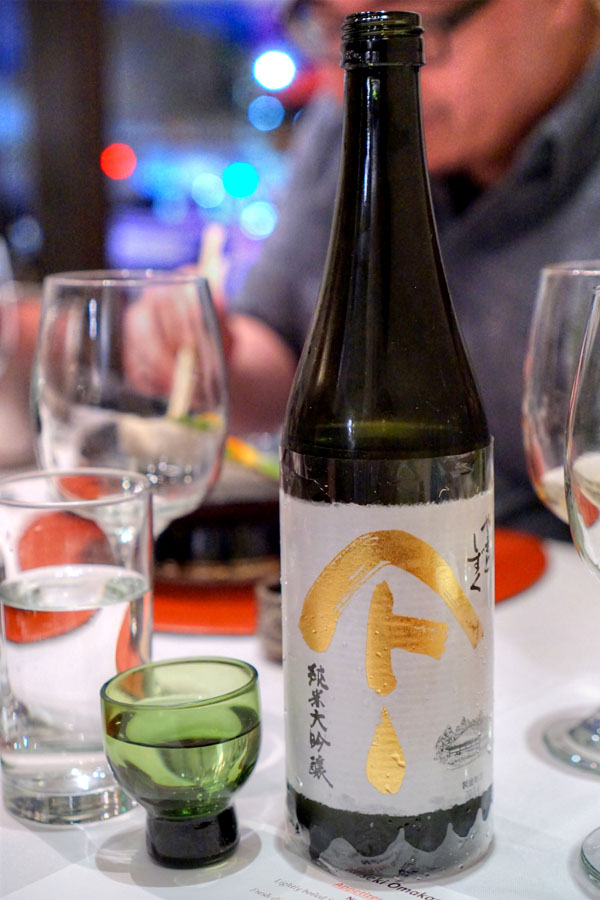
We also had some sake from Matsumoto's list, starting with the Yamatoshizuku [$80], a junmai daiginjo-class brew from producer Akita Seishu. This one smelled sweet and ricey, with a good amount of floral, fruity character. On the palate I found it soft and smooth, with a vibrant, off-dry quality and slight tinge of heat. Quite nice overall.
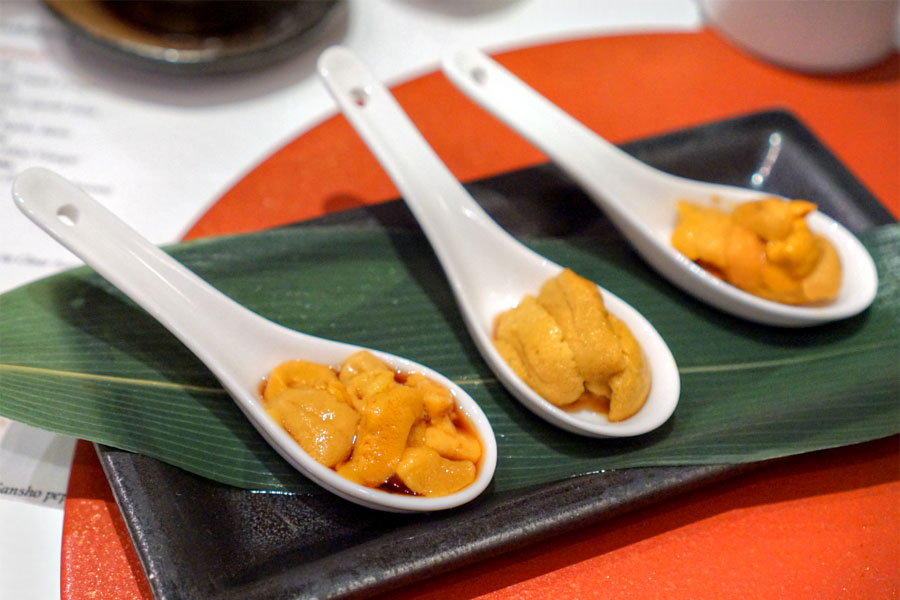
5: {Side Dish/Kawari-Zara} Uni Zanmai | ~Three kinds of Sea Urchin
Here was a fun tasting of three varieties of uni, all from Hokkaido from what I understood: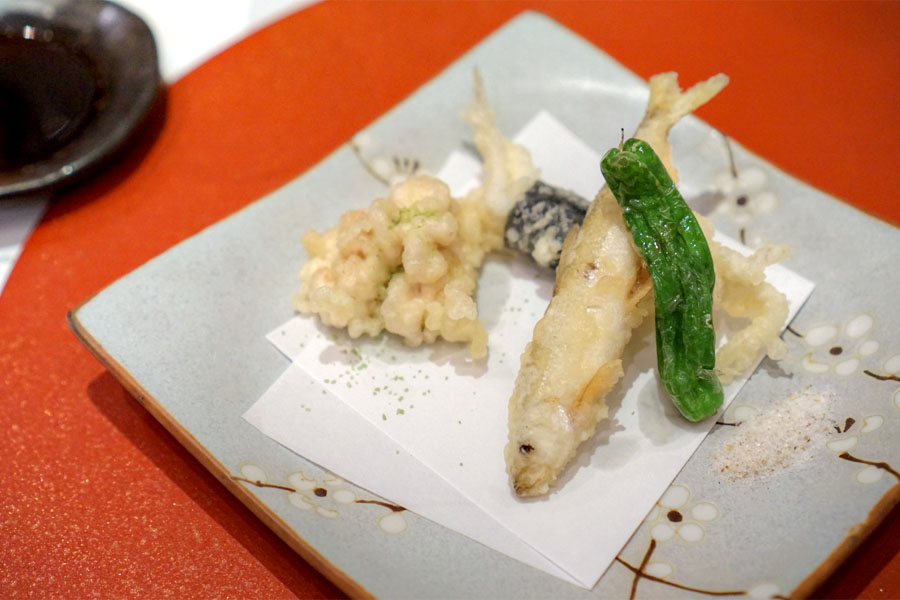
6: {Fried/Agemono} Shirako, Shira Uo, and Wakasagi Tempura | Deep fried Cod Milt w/ Green Tea Sea Salt, Deep Fried Icefish and Smelt Fish w/ Sansho pepper & Sea Salt
Three types of tempura were presented, garnished with a shishito pepper: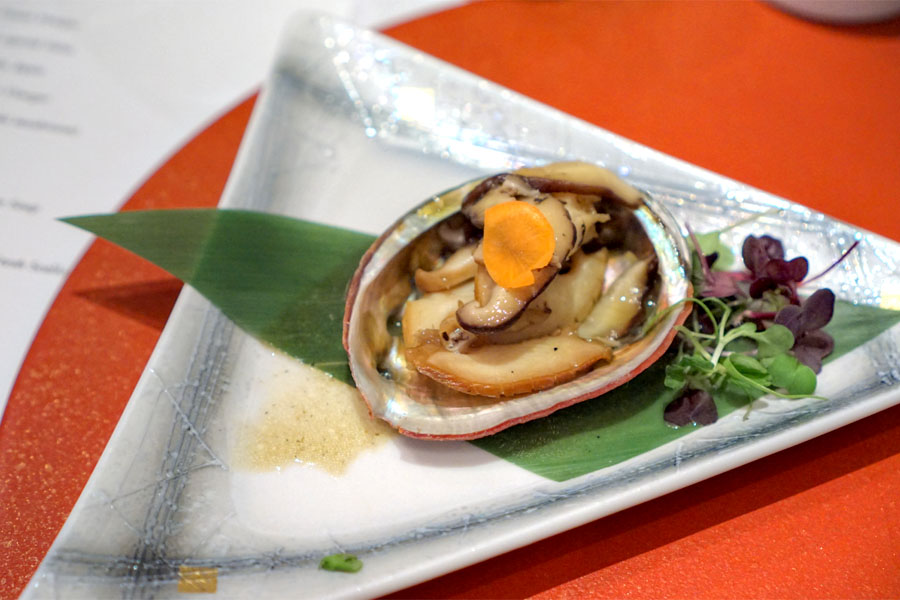
7: {Side Dish/Naka-Zara} Sautéed Awabi | Sautéed Abalone & Mushrooms w/ Special Liver Soy in Shell
Chewy cuts of abalone were enhanced by the savoriness of shiitakes and soy while the greenery on the side offered up a zesty counterweight.
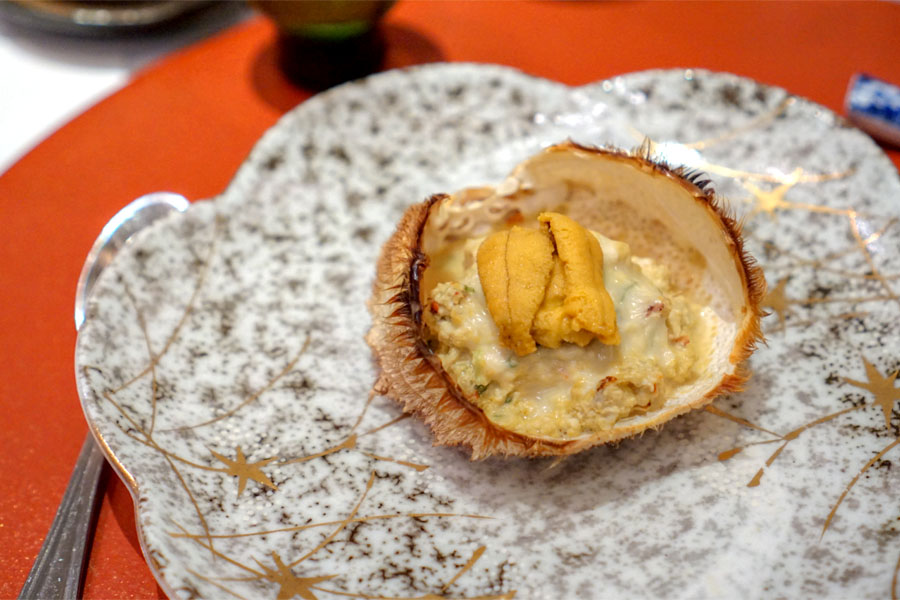
8: {Grilled/Yakimono} Kani Miso Koura Yaki | Hair Crab Miso mixed w/ crab meat, egg & scallions topped w/ Sea Urchin & Melted Cheese in Shell
I was looking forward to the kanimiso kourayaki, given that a version I had at Urasawa was probably the best crab dish I'd ever tasted. Matsumoto's interpretation didn't reach such lofty heights however. Rather, it blended the sweetness of crab with some salty, almost buttery elements, making it a bit clunkier than I would've liked, though the Hokkaido uni on top did offer up a contrast.
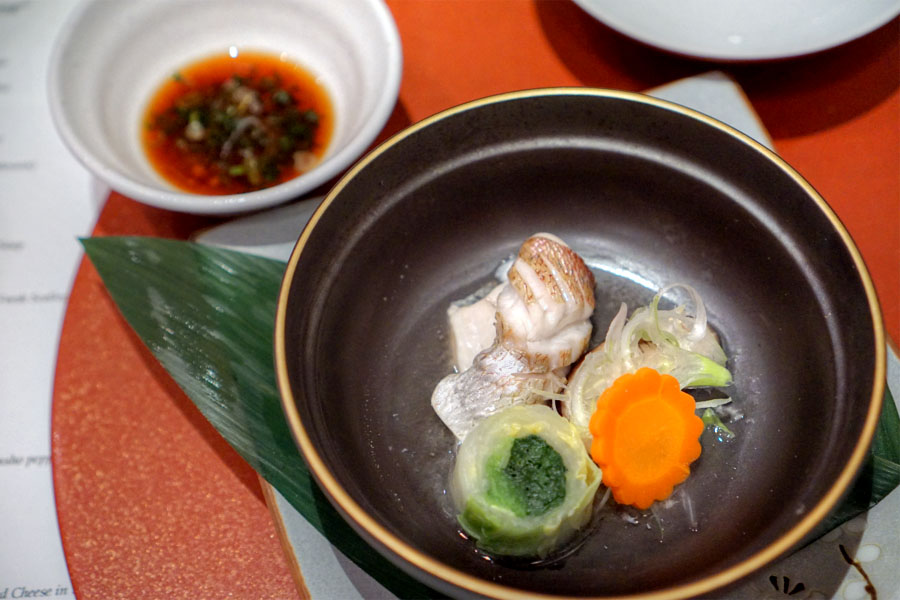
9: {Steamed/Mushimono} Kasukodai no Chiri Mushi | Steamed Baby Snapper & Veges served w/ Ponzu & Green Onions
Young snapper had an satisfyingly meaty consistency, along with a refined brine that really linked up well with the ponzu. I also appreciated the zestiness of the onions here, and the veggies made sense, too.

Next to imbibe was the 2010 En Tirage Blanc de Noirs, a 100% Pinot Noir sparkler that's the sister wine to the BdB above. The nose here was very different, coming across to me as musty and tannic, with far less toast and more red fruit. The palate was definitely more feminine, rounder, softer, with less bite and more lusciousness.
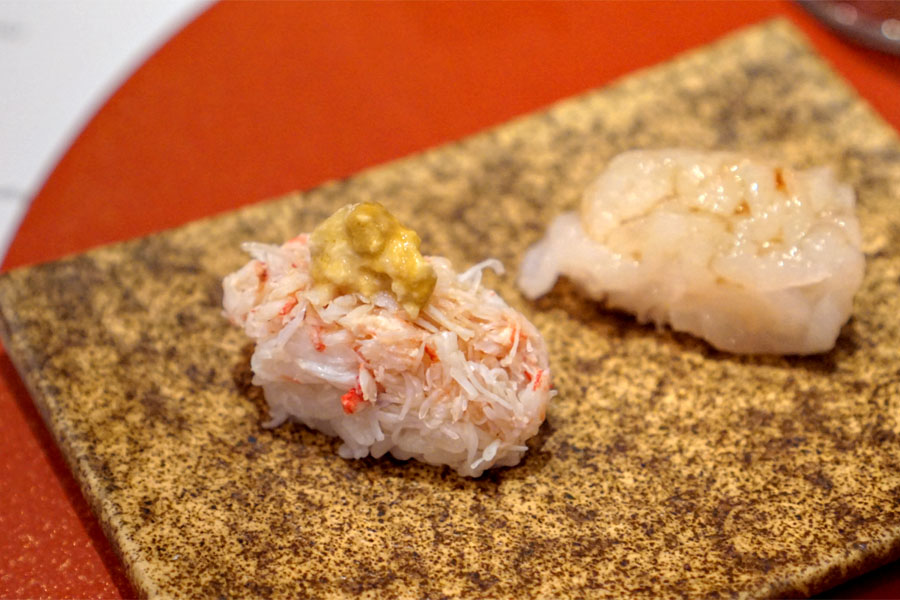
10a: {Sushi/Shokuji} Shiro Ebi, Kegani | Glass Shrimp, Hair Crab
Here came our parade of nigirizushi. I will say that I would've preferred that each piece come out by itself, but that's a relatively minor nit. In any case, Hokkaido hairy crab was wonderfully sweet and briny, and conveyed additional depth courtesy of a rich sauce comprised of what I believe was the crustacean's innards. White shrimp were particularly sweet this evening, and took well to complementary flavors of wasabi and soy, and I especially appreciated the textural variation of the rice.
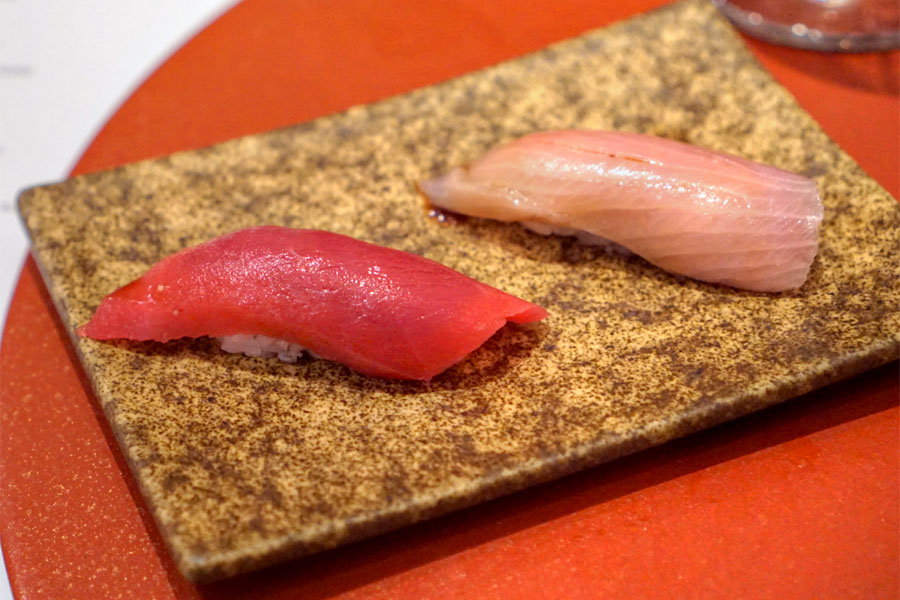
10b: {Sushi/Shokuji} Hon Maguro, Buri | Blue Fin Tuna, Wild Adult Yellowtail
Tuna from Spain was lean and clean tasting, and gave up a lingering prick of wasabi heat on the finish. Wild yellowtail, meanwhile, was less fatty, "crunchier" that what you typically find, and matched swimmingly with a brush of soy sauce. And again, good counterpoint from the rice.
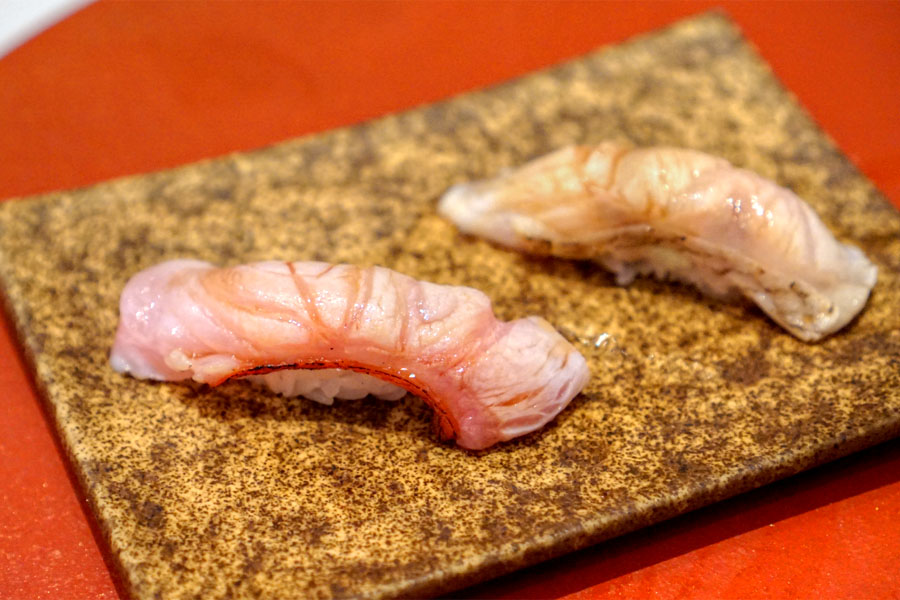
10c: {Sushi/Shokuji} Kinme, Nodoguro | Golden Eye Snapper, Black Throat Perch
Kinmedai was certainly a highlight, its sear and savor working beautifully with the fish's inherent salinity. At the same time, lightly torched akamutsu from Japan was also a joy to eat, and definitely had a softer bite to it.
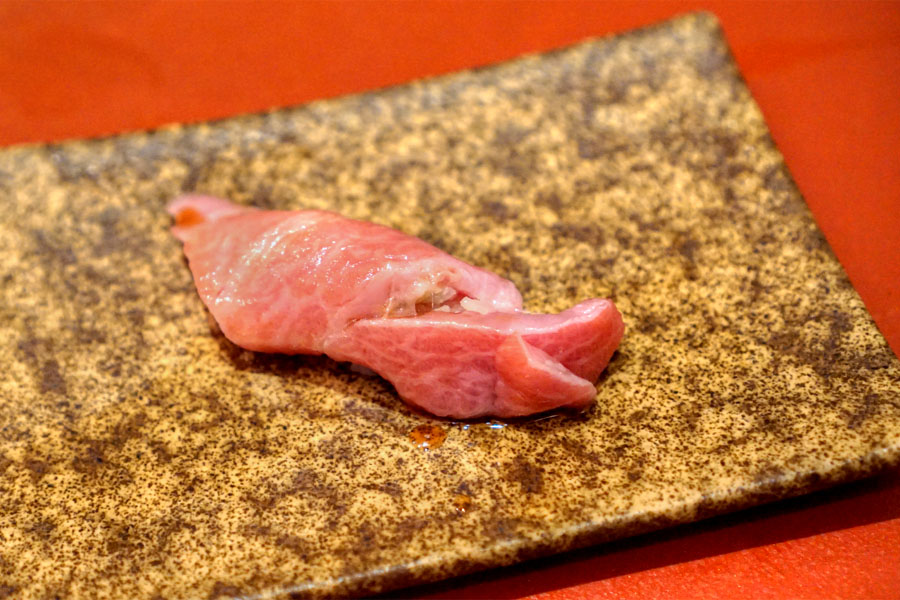
10d: {Sushi/Shokuji} Toro | Supreme Toro
Chef Matsumoto informed us that this was actually kamatoro, a relatively hard-to-find cut that comes from the jaw of the tuna. As expected, this was almost ridiculously fatty, with a melt-in-your-mouth luxuriousness that was really evened out by the soy and rice.
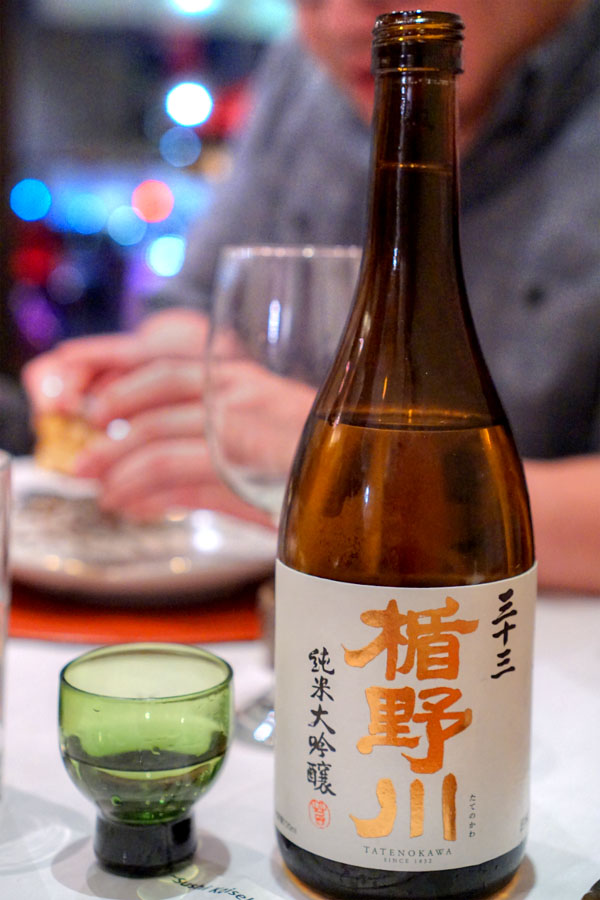
Our second sake was the Tatenokawa 33 [$76], a junmai daiginjo from Yamagata's Tatenokawa Shuzo. Compared to the Yamatoshizuku above, this one had a decidedly less assertive bouquet, but I still got a good amount of ripe melon and sweet rice. On the palate, this was definitely on the smooth, easy-drinking side, though not as expressive with its round, soft character and smidge of heat on the back end.
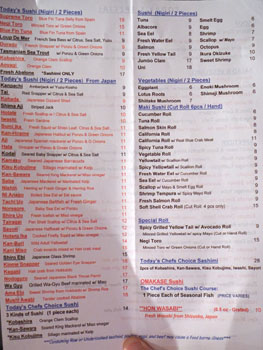
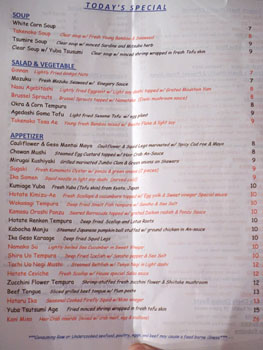
At this point, we decided to add on a number of items from Matsumoto's extensive à la carte menu, which features a good number of more uncommon nigiri. Click for larger versions.
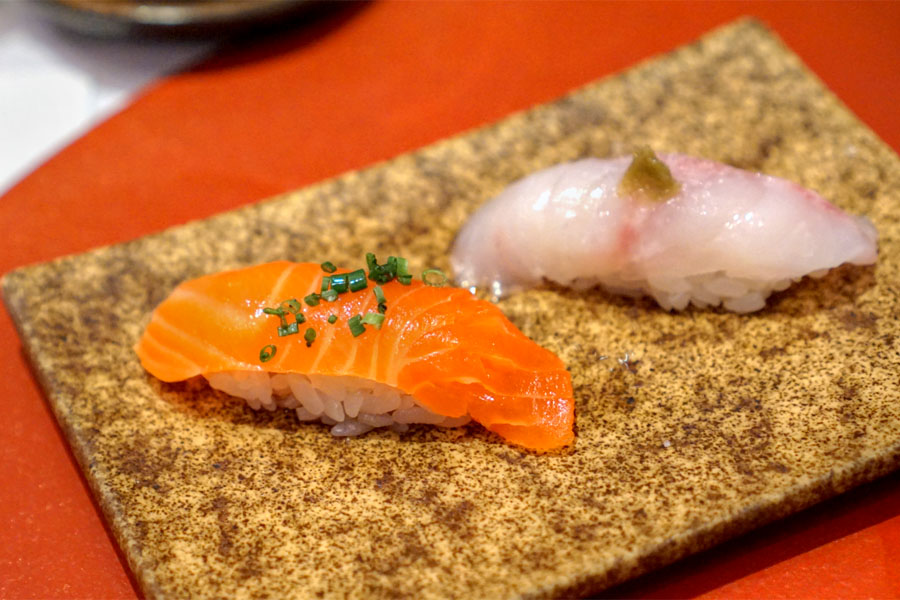
Tasmanian Sea Trout [$4.50] | w/ Ponzu & Green Onions
Loup De Mer [$4.50] | French Sea Bass w/ Citrus, Sea Salt, Yuzu
Masu was leaner than your usual salmon, and had its clean, straightforward taste nicely accented by green onion. The European bass ate firm, and had a relatively mild flavor that was kicked up a notch by the salty-sour blast of yuzukosho.
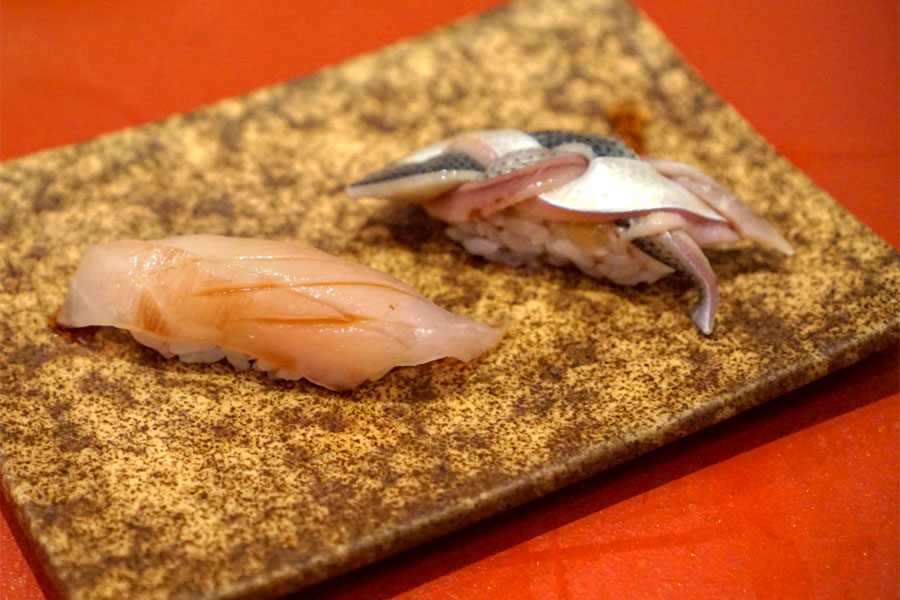
Shima Aji [$5.00] | Striped Jack
Kohada [$4.50] | Japanese Gizzard Shad
Striped jack made sense with its brushing of soy, and had a satisfying snap to it that contrasted well with its base of shari. The soft cut of gizzard shad, on the other hand, had an aggressive, yet never overbearing brininess to it. Note also the braiding effect going on.
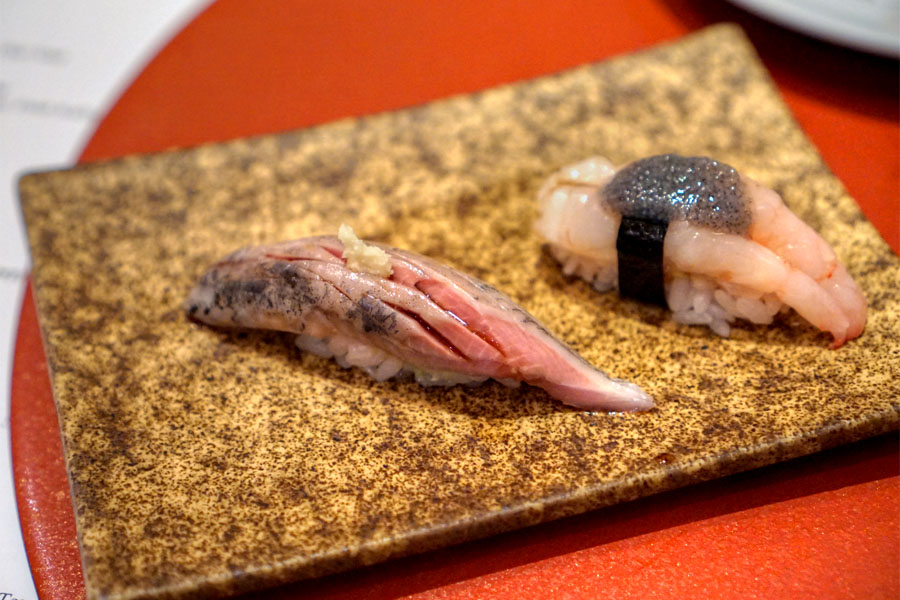
Iwashi [$5.00] | Fresh Sardine
Ama Ebi [$8.50] | Sweet Shrimp from Hokkaido w/ Shrimp Roe
The sardine was on the fishier end of the spectrum, just as you'd expect, but the ginger and rice worked to even things out. Hokkaido sweet shrimp showed off a fantastic brine, and I really appreciated the added complexity from the roe sauce on top. We were also served the lightly-fried heads later on, which were damn tasty.
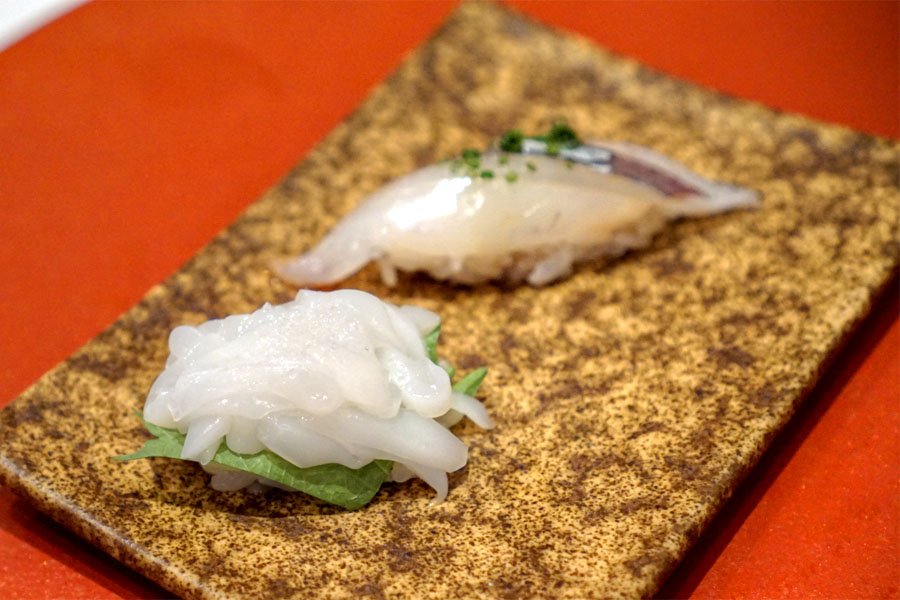
Sumi Ika [$5.50] | Fresh Squid w/ Shiso Leaf, Citrus & Sea Salt
Sayori [$6.00] | Japanese Halfbeak w/ Ponzu & Green Onions
Cuttlefish was both firm and supple, and had its mild flavors underlined by minty shiso and pops of sea salt. More robust was the needlefish, which displayed a considerable brine as well as citric and wasabi accents.
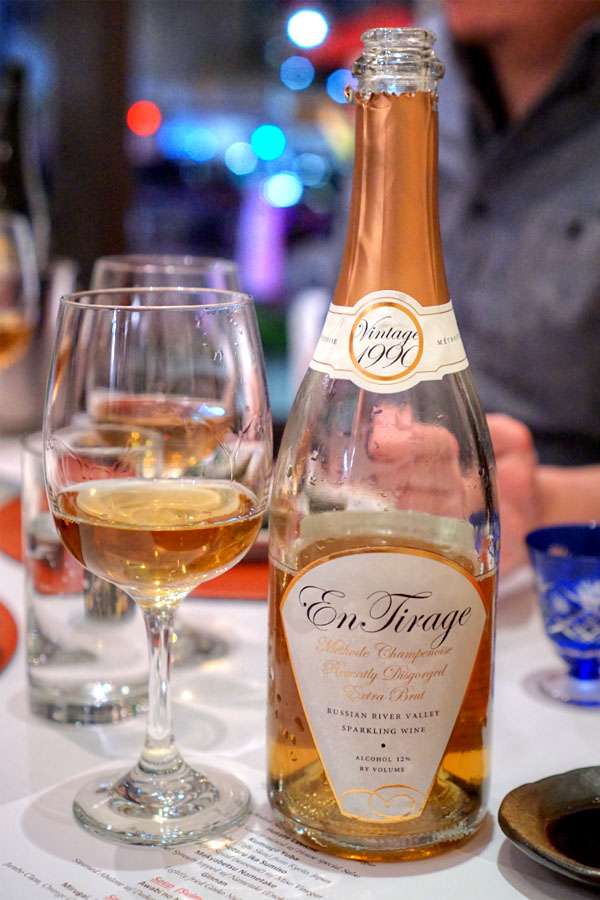
Our final tipple was the 1990 En Tirage Extra Brut, a recently disgorged, 100% Pinot Meunier sparkling wine from the Russian River Valley. Intense, mature nose filled with caramel and toffee, along with an oxidative edge. The palate displayed more aged, oxidative qualities, as well as a distinct breadiness, some fruit, and a honeyed sweetness.
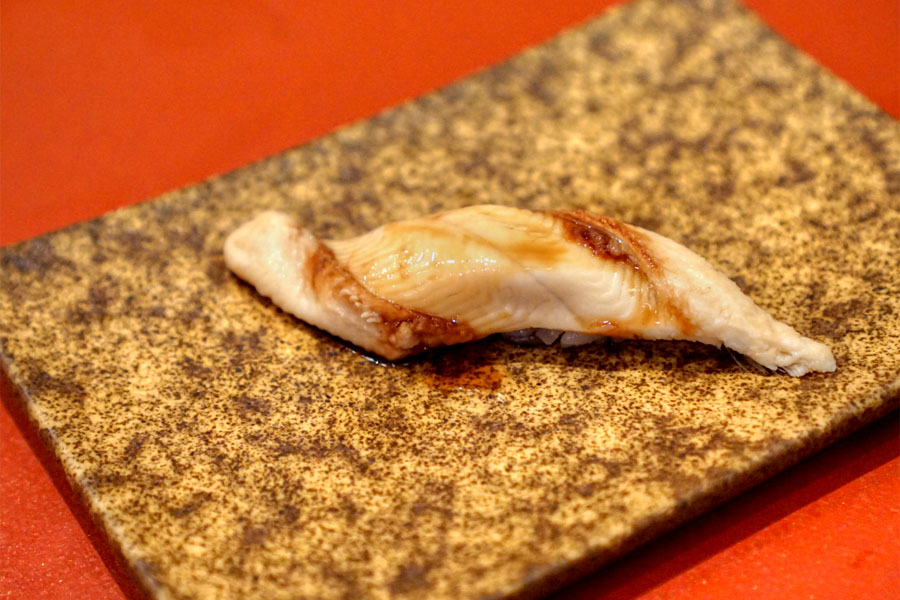
Ni Anago [$6.00] | Boiled Sea Eel w/ Eel sauce
A lean cut of Japanese sea eel meshed in classic fashion with its sweet-ish sauce, while a touch of wasabi on the back end served as an accentuating element.
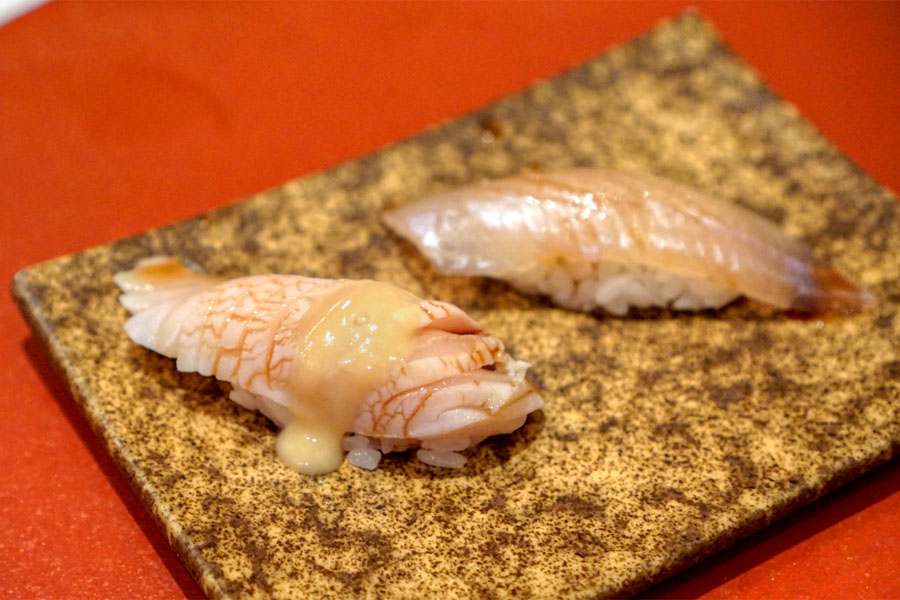
Kan Sawara [$5.50] | Seared King Mackerel w/ Miso vinegar
Kisu Kobujime [$5.50] | Sillago marinated w/ Kelp
A special type of "cold" Spanish mackerel arrived fatty and assertive, with the miso vinegar providing a sweet-savory exclamation point. Kelp-cured shirogisu had a strong sensation of wasabi at first, but that quickly faded, and the kombu really made itself known.

Shira Uo [$5.50] | Fresh Icefish w/ Miso vinegar
We ended with an uncommon neta that I don't think I'd ever had Stateside. A number of these tiny icefish were bundled into one bite. Texturally I'd say they were on the slimier side, and taste-wise they were definitely ocean-y, but well-tempered by the almost fruity sweetness of that miso sauce.
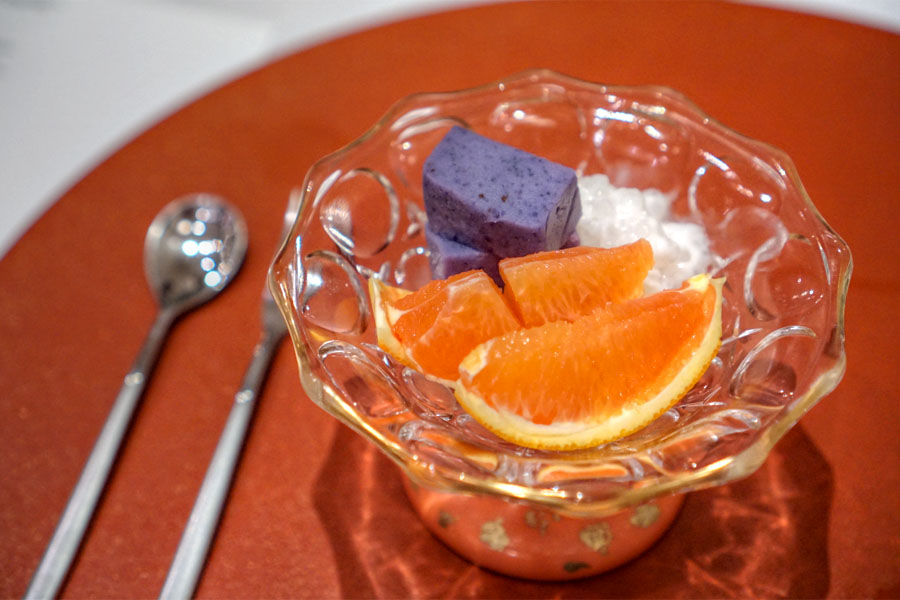
11: {Dessert/Mizugashi} Purple Yam Yokan w/ Coconut Tapioca & Fruits
Dessert was lovely. I got a great back-and-forth between the yokan and tart citrus, while the mild sweetness of the coconut helped bring it all together. Nice and refreshing, especially after all the seafood we just had.
Matsumoto looks to be another strong addition to LA's spectrum of Japanese restaurants. I really appreciated the depth and breadth of the cooking, and you can definitely find things here that you won't encounter at most other establishments. I think it compares quite well with a place like Shunji, and if you come, I'd go for the standard sushi kaiseki omakase, with perhaps a couple supplements.
8385 Beverly Blvd, Los Angeles, CA 90048
323.653.0470
www.matsumoto-restaurant.com
Sat 02/24/2018, 06:00p-10:00p

It'd been a while since I'd done a kaiseki-style meal, and I was recently made aware of such a menu at Matsumoto, which came highly recommended by an acquaintance of mine. The place is basically an evolution of the old Hirozen in Beverly Grove, now run by its former head chef Naruki Matsumoto.
Matsumoto was born in Osaka, and relocated to the US in 1999. He soon secured a position at the Valley's iconic Sushi Nozawa, working under none other than Kazunori Nozawa himself. In 2001, he began cooking at Hirozen Gourmet, a longstanding Japanese eatery that was opened in 1989 by Chef Hiroji Obayashi. He was quickly promoted to head sushi chef, and stayed at that position for 15 years before purchasing the restaurant from Tuk Son Kwak (who'd apparently bought the place in 2010) and re-opening it as Matsumoto in June 2016.

Matsumoto takes over Hirozen's old corner location inside the unassuming Orlando Center strip mall. The decor hasn't changed all that much.



The staff printed out our sushi kaiseki omakase menus ahead of our arrival, which was a nice touch. It normally starts at $160pp, though we'd requested a price point of $250. In hindsight, we probably should've just stuck with the $160, since it didn't seem like the restaurant was quite comfortable with the higher cost. We were also presented with a brief list of sakes and wines, while corkage was $25 a pop. Click for larger versions.

One of my dining companions had brought along three bottles of sparkling wine, which we drank over the course of the meal. Up first was the 2010 En Tirage Blanc de Blancs, composed of 100% Chardonnay from Carneros. On the nose I got a strong toastiness, along with nutty, funky elements and a fruity layer underneath it all. Taste-wise, I found it again bready, nutty, with an oxidative quality, light citrus, and plenty of acidity to boot.


1: {Appetizer/Zensai}
Our first course consisted of a sextet of zensai:
- Mekyabetsu Nametake | Boiled Brussel Sprouts topped w/ Nametake (Enoki mushroom) - Brussels had a satisfying crunch and bite, along with a restrained bitterness and a particularly apparent sweetness. Tasty alone, but even better with a dab of that umami-rich nametake.
- Ginnan | Lightly fried Ginko Nuts - The ginkgo nuts were perhaps the best I've had, with a wonderfully light texture and perfect pops of salt.
- Namako-su | Lightly boiled Sea Cucumber in Sweet Vinegar - Texturally these were firm, almost crunchy, yet yielding at the same time. Flavors veered sweet and tangy, with a definite brine in the background.
- Hotaru Ika Sumiso | Boiled Firefly Squid (seasonal) w/ Miso Vinegar - Firefly squid was well accented by a sweet, savory miso sauce while sheets of seaweed worked as a natural accompaniment.
- Hotate Ceviche | Fresh diced Scallop mixed w/ House special Salsa - Scallops were meaty and fresh, their ocean-y taste working superbly with the acidity and tingling heat from the "pico de gallo."
- Kumiage Yuba | Fresh Yuba (Tofu Skin) from Kyoto, Japan - Bean curd skin was refreshing and mild, with a slight nuttiness, while its silky consistency was almost burrata-like.

2: {Soup/Suimono} Awabi no Mizore Jiru | Steamed Abalone w/ Daikon Radish & Carrots in Clear Soup
Slivers of abalone arrived delightfully tender, their mild brine heightened by strands of seaweed and the dish's mild broth. An appropriate cold weather soup.

3: {Sashimi/Otsukuri} Mirugai, Aoyagi, Tairagai, Sumi Ika, Hotate | Jumbo Clam, Orange Clam, Pen Shell Scallop, Squid w/ Bottarga, Fresh Scallop
Our sashimi moriawase, curiously enough, was comprised solely of shellfish:
- Aoyagi - Soft and spongy, with a mild relish that really called for a dab of wasabi.
- Mirugai - Geoduck came out firm and slightly crunchy, with a definite sweetness to it that opened up with a brush of soy.
- Sumi Ika - This one showed off a persistent dankness due to the application of bottarga.
- Hotate - Beautifully textured and oh-so sweet.
- Tairagai - The pen-shell clam had a crisper consistency and a milder flavor that worked well with the 'sabi.

4: {Grilled/Yakimono} Tachi Uo Shiokoji Yaki | Grilled Beltfish w/ Special Shiokoji Seasoning
A meaty cut of beltfish was excellent, with a balance of brine, char, and sweetness from the shio koji. The preparation actually recalled the ubiquitous dish of saikyo-yaki cod, and I appreciated the counterpoint provided by the tangy, salty hajikami (pickled ginger shoot). The candied kumquat was unexpected, though, and I'm not quite sure it needed to be there.

We also had some sake from Matsumoto's list, starting with the Yamatoshizuku [$80], a junmai daiginjo-class brew from producer Akita Seishu. This one smelled sweet and ricey, with a good amount of floral, fruity character. On the palate I found it soft and smooth, with a vibrant, off-dry quality and slight tinge of heat. Quite nice overall.

5: {Side Dish/Kawari-Zara} Uni Zanmai | ~Three kinds of Sea Urchin
Here was a fun tasting of three varieties of uni, all from Hokkaido from what I understood:
- Ensui Uni - Preserved in sea water without any additives. The most savory of the bunch, with a cool brine and fantastically creamy consistency.
- Shiro Uni - A type of murasaki uni. Slightly more austere I'd say, with a more apparent bitterness.
- Bafun Uni - The sweetest, softest of the threesome for sure.

6: {Fried/Agemono} Shirako, Shira Uo, and Wakasagi Tempura | Deep fried Cod Milt w/ Green Tea Sea Salt, Deep Fried Icefish and Smelt Fish w/ Sansho pepper & Sea Salt
Three types of tempura were presented, garnished with a shishito pepper:
- Shirako - Crispy, but wonderfully creamy on the inside, almost like an egg prepared over hard. Excellent contribution from the green tea salt as well. My favorite of the trio.
- Wakasagi - Well-textured and surprisingly restrained. Great with a dip into the provided salt.
- Shira Uo - Mildly flavored, with a delightful blast of umami from the nori wrapper. Again, great with the salt.

7: {Side Dish/Naka-Zara} Sautéed Awabi | Sautéed Abalone & Mushrooms w/ Special Liver Soy in Shell
Chewy cuts of abalone were enhanced by the savoriness of shiitakes and soy while the greenery on the side offered up a zesty counterweight.

8: {Grilled/Yakimono} Kani Miso Koura Yaki | Hair Crab Miso mixed w/ crab meat, egg & scallions topped w/ Sea Urchin & Melted Cheese in Shell
I was looking forward to the kanimiso kourayaki, given that a version I had at Urasawa was probably the best crab dish I'd ever tasted. Matsumoto's interpretation didn't reach such lofty heights however. Rather, it blended the sweetness of crab with some salty, almost buttery elements, making it a bit clunkier than I would've liked, though the Hokkaido uni on top did offer up a contrast.

9: {Steamed/Mushimono} Kasukodai no Chiri Mushi | Steamed Baby Snapper & Veges served w/ Ponzu & Green Onions
Young snapper had an satisfyingly meaty consistency, along with a refined brine that really linked up well with the ponzu. I also appreciated the zestiness of the onions here, and the veggies made sense, too.

Next to imbibe was the 2010 En Tirage Blanc de Noirs, a 100% Pinot Noir sparkler that's the sister wine to the BdB above. The nose here was very different, coming across to me as musty and tannic, with far less toast and more red fruit. The palate was definitely more feminine, rounder, softer, with less bite and more lusciousness.

10a: {Sushi/Shokuji} Shiro Ebi, Kegani | Glass Shrimp, Hair Crab
Here came our parade of nigirizushi. I will say that I would've preferred that each piece come out by itself, but that's a relatively minor nit. In any case, Hokkaido hairy crab was wonderfully sweet and briny, and conveyed additional depth courtesy of a rich sauce comprised of what I believe was the crustacean's innards. White shrimp were particularly sweet this evening, and took well to complementary flavors of wasabi and soy, and I especially appreciated the textural variation of the rice.

10b: {Sushi/Shokuji} Hon Maguro, Buri | Blue Fin Tuna, Wild Adult Yellowtail
Tuna from Spain was lean and clean tasting, and gave up a lingering prick of wasabi heat on the finish. Wild yellowtail, meanwhile, was less fatty, "crunchier" that what you typically find, and matched swimmingly with a brush of soy sauce. And again, good counterpoint from the rice.

10c: {Sushi/Shokuji} Kinme, Nodoguro | Golden Eye Snapper, Black Throat Perch
Kinmedai was certainly a highlight, its sear and savor working beautifully with the fish's inherent salinity. At the same time, lightly torched akamutsu from Japan was also a joy to eat, and definitely had a softer bite to it.

10d: {Sushi/Shokuji} Toro | Supreme Toro
Chef Matsumoto informed us that this was actually kamatoro, a relatively hard-to-find cut that comes from the jaw of the tuna. As expected, this was almost ridiculously fatty, with a melt-in-your-mouth luxuriousness that was really evened out by the soy and rice.

Our second sake was the Tatenokawa 33 [$76], a junmai daiginjo from Yamagata's Tatenokawa Shuzo. Compared to the Yamatoshizuku above, this one had a decidedly less assertive bouquet, but I still got a good amount of ripe melon and sweet rice. On the palate, this was definitely on the smooth, easy-drinking side, though not as expressive with its round, soft character and smidge of heat on the back end.


At this point, we decided to add on a number of items from Matsumoto's extensive à la carte menu, which features a good number of more uncommon nigiri. Click for larger versions.

Tasmanian Sea Trout [$4.50] | w/ Ponzu & Green Onions
Loup De Mer [$4.50] | French Sea Bass w/ Citrus, Sea Salt, Yuzu
Masu was leaner than your usual salmon, and had its clean, straightforward taste nicely accented by green onion. The European bass ate firm, and had a relatively mild flavor that was kicked up a notch by the salty-sour blast of yuzukosho.

Shima Aji [$5.00] | Striped Jack
Kohada [$4.50] | Japanese Gizzard Shad
Striped jack made sense with its brushing of soy, and had a satisfying snap to it that contrasted well with its base of shari. The soft cut of gizzard shad, on the other hand, had an aggressive, yet never overbearing brininess to it. Note also the braiding effect going on.

Iwashi [$5.00] | Fresh Sardine
Ama Ebi [$8.50] | Sweet Shrimp from Hokkaido w/ Shrimp Roe
The sardine was on the fishier end of the spectrum, just as you'd expect, but the ginger and rice worked to even things out. Hokkaido sweet shrimp showed off a fantastic brine, and I really appreciated the added complexity from the roe sauce on top. We were also served the lightly-fried heads later on, which were damn tasty.

Sumi Ika [$5.50] | Fresh Squid w/ Shiso Leaf, Citrus & Sea Salt
Sayori [$6.00] | Japanese Halfbeak w/ Ponzu & Green Onions
Cuttlefish was both firm and supple, and had its mild flavors underlined by minty shiso and pops of sea salt. More robust was the needlefish, which displayed a considerable brine as well as citric and wasabi accents.

Our final tipple was the 1990 En Tirage Extra Brut, a recently disgorged, 100% Pinot Meunier sparkling wine from the Russian River Valley. Intense, mature nose filled with caramel and toffee, along with an oxidative edge. The palate displayed more aged, oxidative qualities, as well as a distinct breadiness, some fruit, and a honeyed sweetness.

Ni Anago [$6.00] | Boiled Sea Eel w/ Eel sauce
A lean cut of Japanese sea eel meshed in classic fashion with its sweet-ish sauce, while a touch of wasabi on the back end served as an accentuating element.

Kan Sawara [$5.50] | Seared King Mackerel w/ Miso vinegar
Kisu Kobujime [$5.50] | Sillago marinated w/ Kelp
A special type of "cold" Spanish mackerel arrived fatty and assertive, with the miso vinegar providing a sweet-savory exclamation point. Kelp-cured shirogisu had a strong sensation of wasabi at first, but that quickly faded, and the kombu really made itself known.

Shira Uo [$5.50] | Fresh Icefish w/ Miso vinegar
We ended with an uncommon neta that I don't think I'd ever had Stateside. A number of these tiny icefish were bundled into one bite. Texturally I'd say they were on the slimier side, and taste-wise they were definitely ocean-y, but well-tempered by the almost fruity sweetness of that miso sauce.

11: {Dessert/Mizugashi} Purple Yam Yokan w/ Coconut Tapioca & Fruits
Dessert was lovely. I got a great back-and-forth between the yokan and tart citrus, while the mild sweetness of the coconut helped bring it all together. Nice and refreshing, especially after all the seafood we just had.
Matsumoto looks to be another strong addition to LA's spectrum of Japanese restaurants. I really appreciated the depth and breadth of the cooking, and you can definitely find things here that you won't encounter at most other establishments. I think it compares quite well with a place like Shunji, and if you come, I'd go for the standard sushi kaiseki omakase, with perhaps a couple supplements.
7 Comments:
Southern California has the best strip malls in the country. You can take that to the bank.
I've always found the pricing flexibility of Japanese omakase, at some places at least, to be really confusing for both parties. I live in town that is a sushi wasteland compared to LA and there was no omakase in sight. Years ago, an innovative Japanese restaurant opened up that served both good sushi as well as cooked dishes (I like both). I asked them to do omakase and while they were aware of the concept, they had never planned on it. When the waitress came back, she had a question from the chef: "How much?".
This is an awful lot of pressure to put on a diner. I can "afford" a lot. But there are so many questions that come to mind. If I say $35, am I going to miss out on some special item that the $40 level would have afforded? What about $100? Do you even have the ingredients to make an expensive tasting menu like that or are you just going to give me the same food at the $35 level but three times as much quantity?
Similarly, I think you kind of did yourself and the restaurant a disservice by trying to go baller-style with your $250 request. Most places don't think in terms of that. I have also never seen this scenario at non Japanese fine dining. I mean you couldn't tell Providence that you want their Chef's Tasting Menu ($240) but want to pay $400 for it. This is different than supplements which have a set cost ahead of time (ie truffle, foie, etc).
I don't think $250 consider as baller-style for this restaurant, look at all those wine label pictures in yelp....
True omakase shouldn't has a price tag prior to serving. I find it funny to see all those fixed tasting menu titled "Omakase" with a price next to it. A real traditional Japanese chef won't limit the omakase at certain courses and listed it on a prix fixe menu, or ask for how much so that the omakase will keep at certain price point. It totally defeats the meaning of omakase. Just let the chef know your food preference without giving any price limitation, let the chef do the omakase and see if it worth a 2nd visit.
FYI - Sushi Suzuki in Ginza does a set price Omakase. In fact, many Sushi bars in Japan do set price lunch and dinner Omakase, that you can add on to.
Omakase Kaiseki at Onsen that I've been to in Japan have been set price in my limited experience as well.
Anon #1: In terms of sushi, I'd definitely agree.
sygyzy: Some good points. Would you just prefer a fixed price à la Providence then? One thing to add/clarify: doing the sushi kaiseki omakase requires three days advance notice per the restaurant. Thus, we actually had a brief phone consultation with them several weeks prior to our dining date in which the $250 price point was requested. The call is also where you're supposed to discuss any allergies/aversions/special requests.
Anon #2: Indeed. Nobody does baller-style wine like "Dirk B."
itamae/Unknown: I agree, in theory that's how it works, though it's often times not the case, at least in LA. Here though, I think the fixed price makes a bit more sense since the menu requires advance preparation, as noted above.
Anon #3: Where are you seeing $450?
kevin Thanks for the additional background to add insight. For Omakase, yes, I think I would prefer a set price and I think they should only allow deviations if they are truly equipped for it. They can say "If you want to modify the menu or make it a little more special, please contact us". Restaurants who can't handle it, should just be steadfast in their fixed prices/menus.
And for other commenters, yes I know "true" omakase has no price but it's rarely seen (only place I can think of is Go's Mart. And I knew I'd trigger someone with my $250 baller comment. I was trying to make the point that it was more money for omakase than the restaurant was prepared to handle.
Post a Comment
Subscribe to Post Comments [Atom]
<< Home